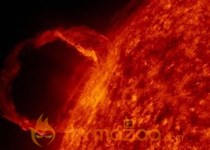It was the breathtaking solar event that sparked spectacular displays of Northern Lights across much of the northern hemisphere.
In August, the sun’s surface suddenly erupted and blasted tons of plasma – ionised atoms – into interplanetary space. It took two days for the atoms to travel the 93 million miles to Earth.
NASA captured images of the event, called a coronal mass ejection, from the Solar Dynamics Observatory (SDO), according to the Journal of Geophysical Research.
Now scientists believe the startling images may have fundamentally changed how we think about the sun’s surface, reports the Daily Mail.
NASA experts say that what was dubbed a ’solar tsunami’ shows that explosions on the sun are not isolated events but are interconnected by magnetism over huge distances.
Solar flares, tsunamis, coronal mass ejections can go off all at once, hundreds of thousands of miles apart, in a massively complex concert of mayhem.
Karel Schrijver of the Lockheed Martin’s Solar and Astrophysics Lab said: “The August 1st event really opened our eyes. We see that solar storms can be global events, playing out on scales we scarcely imagined before.”
His colleague Alan Tite studied data recorded by both the SDO and twin STEREO spacecraft. SDO provides better-than-HD quality views of the sun at a variety of wavelengths.
Tite said: “To predict eruptions we can no longer focus on the magnetic fields of isolated active regions. We have to know the surface magnetic field of practically the entire sun.”
The discovery has huge implications beyond astronomy as many experts believe that a solar tsunami similar to the one in August could one day cause havoc with satellite communication systems, electric power grids and aircraft.







